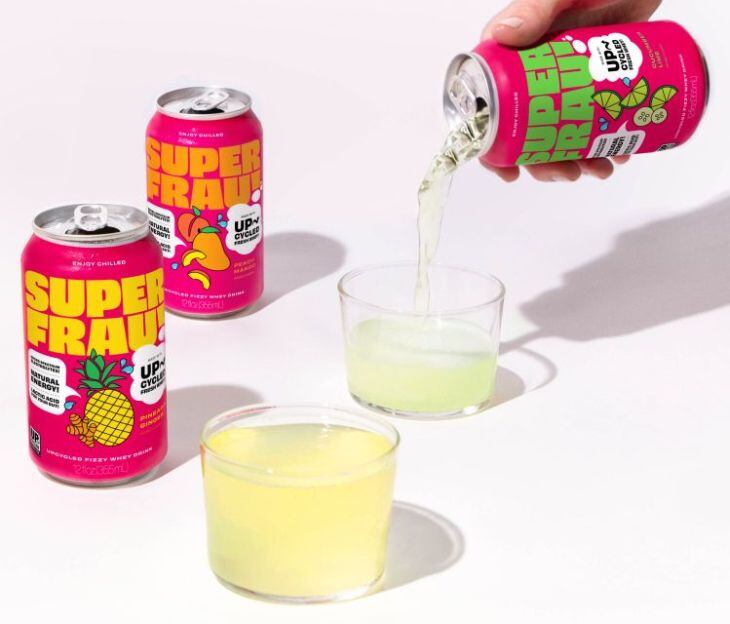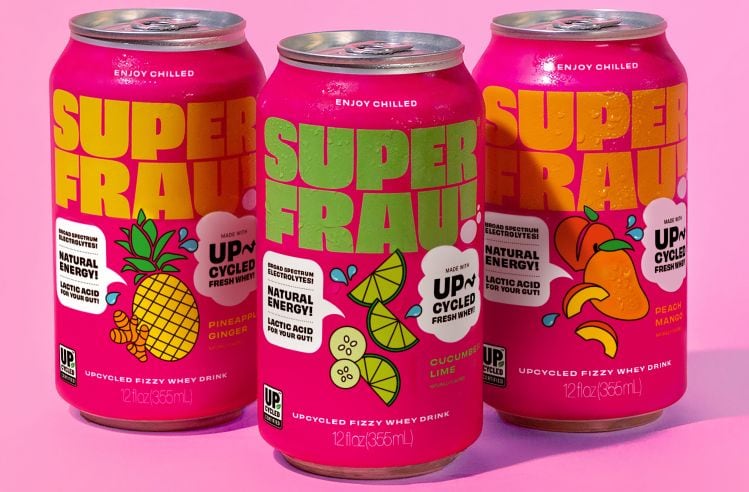The ‘slightly tart, slightly sweet’ carbonated beverage – which contains natural flavors – also contains lactase enzyme to break down lactose (milk sugar) from the whey into simpler sugars for a ‘lactose-free’ positioning.
It's whey… but it's not Muscle Milk…
The electrolyte-packed beverage – which contains meaningful levels of calcium, riboflavin, phosphorous, thiamin, vitamin B12, pantothenic acid, zinc, potassium, magnesium and selenium - doesn’t look or taste like milk and is not a high-protein beverage (it has 3g protein) like Muscle Milk, stresses Superfrau founder Melissa Martinelli.
Hence the decision to package it in a brightly colored can and home in on its key functional attributes – notably a broad spectrum of electrolytes, B vitamins (including 25% of the RDA for B12) and lactic acid - explains Martinelli, who acknowledges that the biggest challenge has been working out how best to position her product.
“When I’ve been doing sampling and hearing people's feedback, there’s always an association with whey and protein, so there's a lot of education, as it’s not a high-protein drink.
“And while it contains dairy, it’s lactose-free, so part of the reason we chose the [bright, soda-like] packaging was to create a clear disconnect [from consumer associations with whey], says Martinelli, an immigration attorney turned beverage entrepreneur whose entrepreneurial juices started flowing when she first tried whey drinks during a visit to Austria.
“My husband is from Austria, where they have a very popular drink [Latella] made with fresh liquid whey. I tried it, and it was so refreshing and satisfying and nutritious, so I saw a really compelling waste to value opportunity. There's also a popular Swiss drink called Rivella.
"So Lattella and Rivella were our main inspirations, which are both made with sweet whey [from cheese rather than strained yogurt production], but after a couple years of product development, we landed on acid whey from yogurt as our main ingredient both for the unique tart flavor profile, and the fact that there are fewer uses for it currently in our supply chain. The acidity also helped with our goal of making the product shelf stable."
‘Slightly sweet and slightly tart’
The target market for Superfrau, which has secured an Upcycled Certified badge from the Upcycled Foods Association, is “older Gen Z and younger millennials that truly do care and prioritize not just what they put in their body but their personal impact on the environment,” believes Martinelli, who has developed on-trend flavors such as cucumber lime and hibiscus orange.
While attempts to introduce Rivella to the US market were not a success back in the early 2000s, the market has evolved considerably since then, she says.
“I think our timing is good [to bring a slightly sour and salty tasting functional beverage to market] as kombucha came before us and other functional beverages that kind of paved the way for a new flavor profile that's not so sweet. Our flavor profiles at Superfrau offer a nice combination of slightly sweet and slightly tart.
“We're trying to make dairy fun and more relatable to this next generation of consumers. I think there's a white space in this energy category that is targeted towards women. Liquid whey has so many benefits – electrolytes, B vitamins, and no sweeteners. It has 100 calories per can but it’s very satisfying, plus there are the beneficial acids for the gut.”
‘The day we launched our online platform, a local buyer from Whole Foods reached out’
Like most beverage startups, Superfrau has been through a series of packaging, formulation, and branding evolutions, shifting from a refrigerated product in a bottle to a carbonated beverage in a can with a bright functional soda vibe (think Poppi, Olipop, and Culture Pop) that quickly caught the attention of buyers at Whole Foods.
“The day we launched our online platform [in October 2021], a local buyer from Whole Foods reached out to see about getting us on shelves in Whole Foods in our region, and it's really just been a wild journey from there," says Martinelli.
“We officially launched into Whole Foods in the New England area in the spring of 2022 at $3.49 in the refrigerator as a single unit grab and go next to the Kombucha, coconut waters, and other energy drinks, and now we're in all 43 stores in the region and we have a great distribution partner that will help us expand beyond the region.
"We are also available on GoPuff nationwide as part of their Put Me On accelerator, select Big Y Stores, and a number of mom and pops and specialty retailers throughout the country, distributed locally primarily through Rainforest and Marty’s Local, and nationally through Faire."

Ingredients, Superfrau upcycled fizzy whey drink: Fresh whey, natural flavors, citric acid, lactase enzyme
Nutrition Facts per 12oz can: 100 calories, 18 sugar, 0g added sugar, 3g protein, B vitamins (25% RDA vit B12), calcium, electrolytes
Handling acid whey
For those unfamiliar with whey, there are two types: sweet whey, a byproduct of hard and rennet cheese production, which is dried and used in myriad food applications; and ‘acid’ whey, a byproduct of cottage cheese and strained yogurt (Greek, Skyr etc) production, which has historically been a cost rather than a profit center for dairy processors.
While multiple firms are working on ways to turn acid whey from a cost into a revenue stream, dairy processors still typically pay farmers to haul it off their property and deal with it (it can be used in some animal feed supplements or as a liquid fertilizer, or fed into bio-digesters), says Martinelli.
“The main difference is the acidity level, which makes it more difficult to try and concentrate it to make a whey powder, but the fresh liquid whey has an amazing nutritional profile for humans [if you use it fresh as a liquid ingredient rather than drying and concentrating it, where its acidity becomes an issue]. We don’t treat the whey with anything else to make it more palatable. It’s pretty light, tart, and refreshing on its own when it’s fresh."
Dairy processors, she says, “are starting to reevaluate a little bit more and looking at ways to treat this as a food grade product. It does require some reconfiguration of a facility, but not a major investment in equipment to dry and concentrate.
“One of the bigger challenges is that it’s a liquid, so it’s heavy to transport, so one idea is that you build this into your infrastructure so that you're making not just Greek yogurt [for example], but also products that can be made from the liquid whey at the same site.”
‘Making it shelf-stable was really a game changer’
In Superfrau’s case, Martinelli’s main liquid whey supplier is in Pennsylvania: “We coordinate when they do a manufacturing [run of Greek yogurt] and we organize to pick up the whey co-product when it's fresh. We don't pay for the whey, so our main ingredient is free, but we obviously pay for the hauling [to a facility where it’s pasteurized, carbonated and put into cans].”
The original, chilled product, which Martinelli sold at farmers markets, fitness studios and specialty retailers in Boston in 2019, helped generate a buzz that in turn enabled her to get into a Pepsi accelerator program “that came with a grant which allowed me to invest in product development to get on a path to make it shelf stable,” she says.
“Making it shelf-stable was really a game changer as it allowed us to offer it online and connect with our target market in a totally different way.”
Pricing will come down with scale
As for pricing, it will come down with scale, said Martinelli, who has attracted pre-seed investors including Stonyfield co-founder Gary Hirshberg and has been part of Rabobank’s FoodBytes! Program this year.
“We have larger runs coming up where we'll get our cost of goods down and we can get our pricing down as well. So that's an exciting place to be while other brands [facing surging inflation on ingredients] are really challenged.
“We actually have really great margins, especially for a startup, and a strong business model, and I think that really sets us apart from a lot of other emerging brands.”

